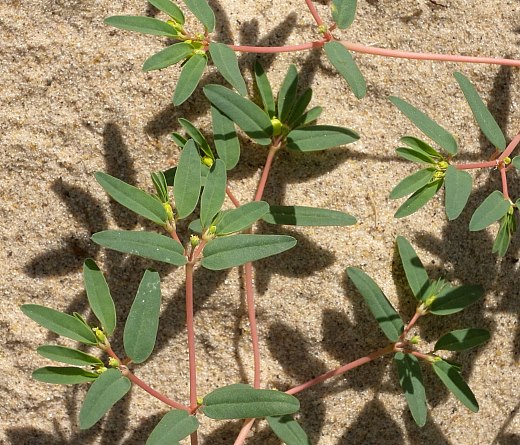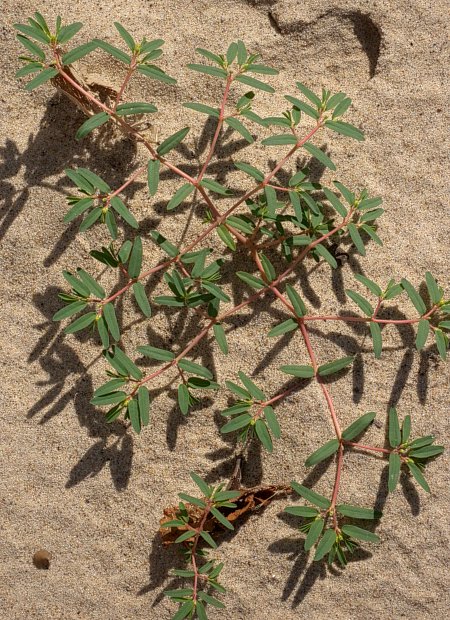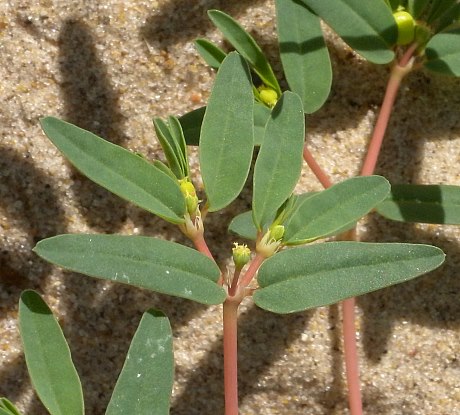
Tiny flowers with cyathia (cup-like structures) develop near pairs of leaves; there is normally only a single cyathium (cup-like structure) per pair of leaves. The cyathium is less than 2 mm. long; its outer surface is light green and hairless. Each cyathium has a short stalk at its base that is terete and pale red. Along the upper rim of the cyathium, there are 4 nectar glands with tiny petaloid appendages. These petaloid appendages are white and barely perceptible without magnification; sometimes they are absent. Between the nectar glands along the upper rim of the cyathium, there are tiny linear-lanceolate lobes that are erect. From the center of the cyathium, there develops a single female flower on a short stout pedicel that becomes more long and curved with age. The female flower consists of a naked 3-celled ovary with a short tripartite style at its apex. This ovary is light green, hairless, and globoid in shape. Several male flowers develop underneath the female flower within the cyathium; each male flower consists of a single stamen. The blooming period occurs from mid-summer into the fall. The ovaries of female flowers develop into seed capsules about 1/8" (3.0-3.5 mm.) across; these capsules are globoid with 3 shallow longitudinal lobes and they are hairless. Each cell of a capsule contains 1-2 seeds that are 2.0-2.5 mm. long, narrowly ovoid in shape, and relatively smooth (although minutely pitted under magnification). Seeds are ejected from their capsules at maturity. The root system consists of a slender branching taproot. This plant spreads by reseeding itself.
Cultivation: The preference is full sun, mesic to dry conditions, and very sandy soil. This little plant has a C4 metabolism, which enables it to withstand hot dry conditions.

Range & Habitat: The native Seaside Spurge is found primarily along Lake Michigan; it has also been found in Fulton County, although this interior location is highly unusual for this species (see Distribution Map). Seaside Spurge is rare in Illinois and state-listed as 'endangered.' Outside of the state, this species is found along the coastal areas of the Great Lakes (except for Lake Superior) and it is also found along the Atlantic coast, particularly in sandy areas such as beaches. In Illinois, habitats consist of sandy beaches along Lake Michigan, sand dunes near Lake Michigan, and a dry sand prairie in Fulton County. This plant is very specialized in its habitat preferences; it is vulnerable to development in coastal areas and trampling by people along beaches.
Faunal Associations: The flowers attract small bees and flies (mainly Syrphidae). These insects obtain nectar from the flowers; in addition, the bees may collect pollen. Insects that feed on the foliage or plant juices of Chamaesyce spp. (Prostrate Spurges) include the aphid Macrosiphum euphorbiae, the plant bug Semium hirtum, and the leaf beetle Glyptina leptosoma. Bird that eat the seeds of these plants include the Greater Prairie Chicken, Northern Bobwhite, Horned Lark, Chipping Sparrow, and Mourning Dove. Because the seeds have oily elaiosomes, they are dispersed to some extent by ants.

Photographic Location: A sandy beach at Indiana Dunes State Park in NW Indiana.
Comments: Some authorities refer to this species as Euphorbia polygonifolia. Seaside Spurge is a member of a small group of prostrate spurges (Chamaesyce spp.) that are often difficult to distinguish. They are mainly native to Illinois, although a few species are adventive from the western states. Seaside Spurge can be be distinguished from most species in this genus by its hairless leaves and stems, its hairless ovaries and seed capsules, and the smooth toothless margins of its leaves. Another prostrate spurge, Chamaesyce geyeri (Geyer's Spurge), also has these characteristics, but its seeds (about 1.5 mm. long) and seed capsules (2.0-2.5 mm. long) are smaller in size than those of Seaside Spurge.